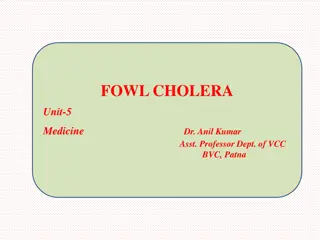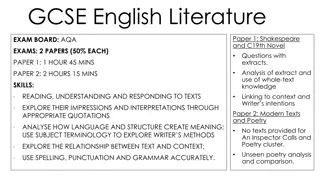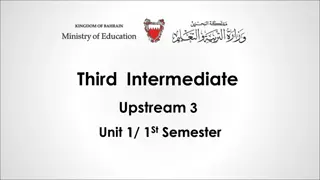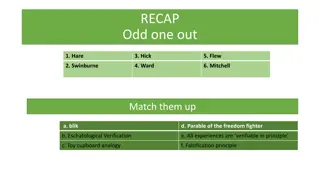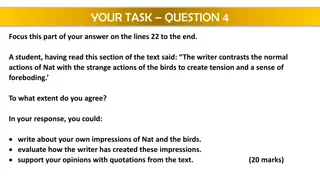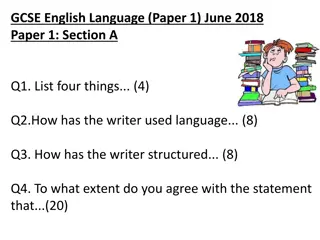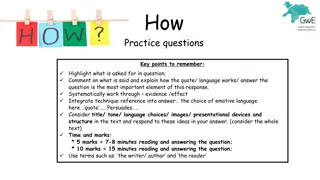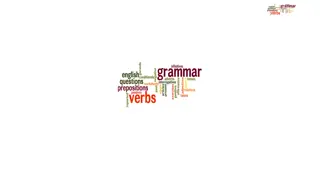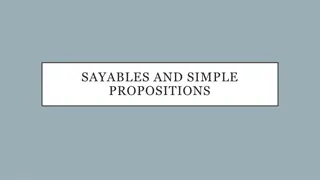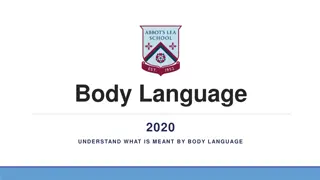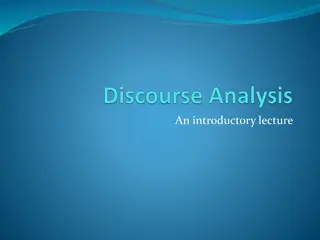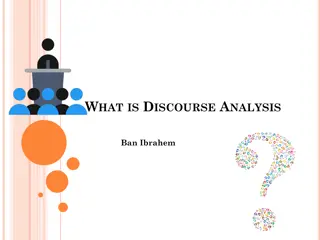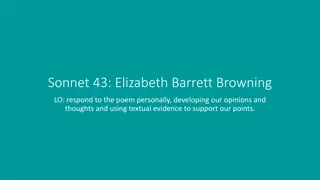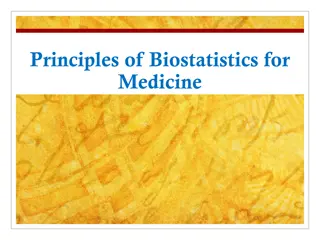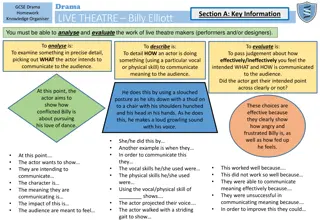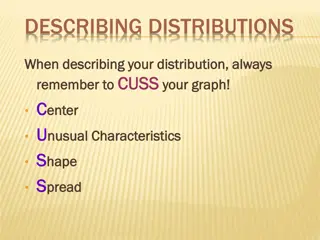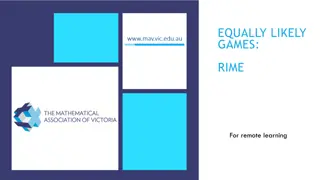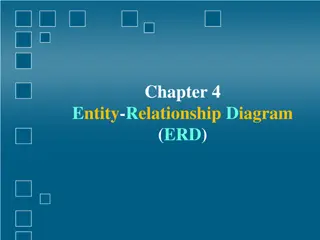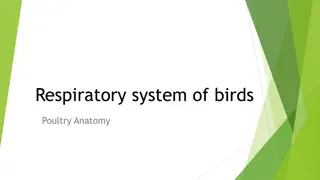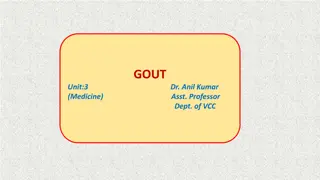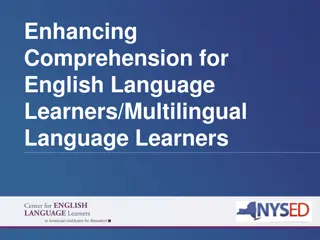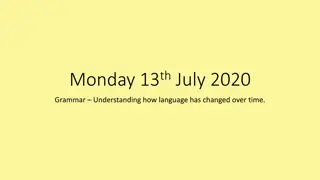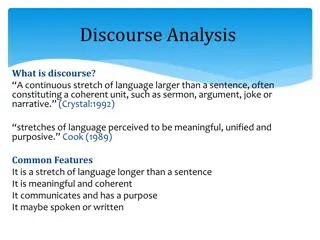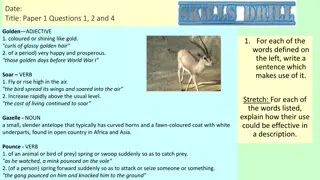Analyzing Language in Describing Birds
Delve into the writer's use of language in vividly describing the behaviors of different bird species in the given extract. Explore how words, phrases, and language techniques are employed to depict the restlessness, movement, and interactions among the birds, creating a dynamic and engaging portrayal. Unpack the effects the writer aims to achieve through detailed descriptions of the birds' actions and characteristics.
Download Presentation

Please find below an Image/Link to download the presentation.
The content on the website is provided AS IS for your information and personal use only. It may not be sold, licensed, or shared on other websites without obtaining consent from the author. Download presentation by click this link. If you encounter any issues during the download, it is possible that the publisher has removed the file from their server.
E N D
Presentation Transcript
YOUR TASK: CONSIDERING QUESTION 2 Q2: Look in detail at this extract from lines 14 to 21 of the source: Inference Great flocks of them came to the peninsula, restless, uneasy, spending themselves in motion; now wheeling, circling in the sky, now settling to feed on the rich, new-turned soil; but even when they fed, it was as though they did so without hunger, without desire. Restlessness drove them to the skies again. Making a prediction about something based on evidence. Analysis Black and white, jackdaw and gull, mingled in strange partnership, seeking some sort of liberation, never satisfied, never still. Flocks of starlings, rustling like silk, flew to fresh pasture, driven by the same necessity of movement, and the smaller birds, the finches and the larks, scattered from tree to hedge as if compelled. A detailed examination of the elements in a text. An explanation as to WHY writers do what they do. Analysis includes discussion of the effects writers want to achieve and how they achieve it. How does the writer use language to describe the birds? (8 marks) You could include the writer s use of: - - - words and phrases language features and techniques sentence forms
WHAT THE EXAMINER WILL SEE SIMPLE AWARENESS OF LANGUAGE (L1) Simple comment on the effect of language (L1) Simple textual detail (L1) Simple use of subject terminology (L1) Candidate s answer will appear here on the examiner s marking screen. SOME UNDERSTANDING OF LANGUAGE (L2) Attempt to comment on the effect of language (L2) Some appropriate textual detail (L2) Some use of subject terminology (L2) CLEAR UNDERSTANDING OF LANGUAGE (L3) Clear explanation of the effects of language (L3) Range of relevant textual detail (L3) Clear/accurate use of subject terminology (L3) DETAILED AND PERCEPTIVE UNDERSTANDING OF LANGUAGE (L4) Analysis of the effects of language (L4) Judicious textual detail (L4) Sophisticated use of subject terminology (L4)
WHAT THE EXAMINER WILL SEE The examiner will see the candidate s answer to the right of these comments. SIMPLE AWARENESS OF LANGUAGE (L1) Simple comment on the effect of language (L1) Simple textual detail (L1) Simple use of subject terminology (L1) The examiner will then click and drag these comments onto your answer to show where you have met the criteria. SOME UNDERSTANDING OF LANGUAGE (L2) Attempt to comment on the effect of language (L2) Some appropriate textual detail (L2) Some use of subject terminology (L2) CLEAR UNDERSTANDING OF LANGUAGE (L3) Clear explanation of the effects of language (L3) Range of relevant textual detail (L3) Clear/accurate use of subject terminology (L3) This means that part of your answer could contain a L1 comment but also a L4 comment. This means that if part of your answer is L4 but the rest is L1, you will receive a mark in the L4 section of the mark scheme. DETAILED AND PERCEPTIVE UNDERSTANDING OF LANGUAGE (L4) Analysis of the effects of language (L4) Judicious textual detail (L4) Sophisticated use of subject terminology (L4)
YOUR TASK: BE THE EXAMINER. MARK THE FOLLOWING ANSWERS Annotate the following answers with the comments on the left. See if you can identify the highest level the answer achieves and where it achieves it. SIMPLE AWARENESS OF LANGUAGE (L1) Simple comment on the effect of language (L1) Simple textual detail (L1) Simple use of subject terminology (L1) SOME UNDERSTANDING OF LANGUAGE (L2) Attempt to comment on the effect of language (L2) Some appropriate textual detail (L2) Some use of subject terminology (L2) CLEAR UNDERSTANDING OF LANGUAGE (L3) Clear explanation of the effects of language (L3) Range of relevant textual detail (L3) Clear/accurate use of subject terminology (L3) DETAILED AND PERCEPTIVE UNDERSTANDING OF LANGUAGE (L4) Analysis of the effects of language (L4) Judicious textual detail (L4) Sophisticated use of subject terminology (L4)
YOUR TASK: BE THE EXAMINER (CANDIDATE ONE) The writer describes the birds as arriving in greatflocks , saying the are both SIMPLE AWARENESS OF LANGUAGE (L1) Simple comment on the effect of language (L1) Simple textual detail (L1) Simple use of subject terminology (L1) restless and uneasy. The use of these adjectives creates a sense of foreboding, as if the birds themselves are waiting for something dark and SOME UNDERSTANDING OF LANGUAGE (L2) Attempt to comment on the effect of language (L2) Some appropriate textual detail (L2) Some use of subject terminology (L2) sinister to occur. This juxtaposes the stereotypical image of birds as carefree creatures that soar through the air, an image du Maurier herself references with the simile starlings, rustling like silk. The noun silk connotes softness CLEAR UNDERSTANDING OF LANGUAGE (L3) Clear explanation of the effects of language (L3) Range of relevant textual detail (L3) Clear/accurate use of subject terminology (L3) and delicacy, presenting these birds as anything but a threat. Silk itself can ripple, much like the movements of flocks of birds, a beautiful image now tainted by the fact they are restless. Du Maurier may be doing this to make DETAILED AND PERCEPTIVE UNDERSTANDING OF LANGUAGE (L4) Analysis of the effects of language (L4) Judicious textual detail (L4) Sophisticated use of subject terminology (L4) her readers feel uncertain of what these birds will do; indeed their movements seen unpredictable through du Maurier s constant repetition of the adverb now , implying the birds are everywhere at once.
YOUR TASK: BE THE EXAMINER (CANDIDATE TWO) The writer describes the birds as arriving in greatflocks which shows there SIMPLE AWARENESS OF LANGUAGE (L1) Simple comment on the effect of language (L1) Simple textual detail (L1) Simple use of subject terminology (L1) are a lot of them. She also says they are restless and uneasy which means that something has probably disturbed them or maybe even angered them SOME UNDERSTANDING OF LANGUAGE (L2) Attempt to comment on the effect of language (L2) Some appropriate textual detail (L2) Some use of subject terminology (L2) as they are not calm and peaceful. The writer then creates a striking image of black and white birds flying together, mingled in strange partnership, seeking some sort of liberation. This is an odd image. Liberation suggests CLEAR UNDERSTANDING OF LANGUAGE (L3) Clear explanation of the effects of language (L3) Range of relevant textual detail (L3) Clear/accurate use of subject terminology (L3) freedom and escape, yet the verb seeking implies that the birds do not think they are free despite the fact that nothing is keeping them restrained. Perhaps this is the source of their restlessness but this creates a sense of DETAILED AND PERCEPTIVE UNDERSTANDING OF LANGUAGE (L4) Analysis of the effects of language (L4) Judicious textual detail (L4) Sophisticated use of subject terminology (L4) unease because nothing is keeping them imprisoned. The repetition of the adverb never shows how the birds are desperate to keep moving; perhaps they are afraid of keeping still.
YOUR TASK: BE THE EXAMINER (CANDIDATE THREE) The writer says the birds are restless and uneasy which shows that they SIMPLE AWARENESS OF LANGUAGE (L1) Simple comment on the effect of language (L1) Simple textual detail (L1) Simple use of subject terminology (L1) cannot keep still because the are uneasy . They keep on wheeling and circling the sky which shows they are flying around. They are all mixed up SOME UNDERSTANDING OF LANGUAGE (L2) Attempt to comment on the effect of language (L2) Some appropriate textual detail (L2) Some use of subject terminology (L2) together because all the jackdaws and the gulls are flying around together. It also says the birds are scattered. This is an adjective. There are lots of birds here which can be quite scary. The colours of the birds are also CLEAR UNDERSTANDING OF LANGUAGE (L3) Clear explanation of the effects of language (L3) Range of relevant textual detail (L3) Clear/accurate use of subject terminology (L3) described as being black and white . The writer also talks about smaller birds which shows they are different sizes. The birds are probably quite loud if there are lots of them flying around together which shows how noisy the DETAILED AND PERCEPTIVE UNDERSTANDING OF LANGUAGE (L4) Analysis of the effects of language (L4) Judicious textual detail (L4) Sophisticated use of subject terminology (L4) can be. The writer says they are neverstill which shows they never stop flying around.
YOUR TASK: BE THE EXAMINER (CANDIDATE FOUR) The writer describes the birds using the adjectives restless and uneasy SIMPLE AWARENESS OF LANGUAGE (L1) Simple comment on the effect of language (L1) Simple textual detail (L1) Simple use of subject terminology (L1) which shows that something is bothering the birds. Usually birds are carefree and can fly away from danger but they so not fly away here so they SOME UNDERSTANDING OF LANGUAGE (L2) Attempt to comment on the effect of language (L2) Some appropriate textual detail (L2) Some use of subject terminology (L2) remain uneasy . The verbs wheeling and circling shows how the birds can fly around freely and easily. The writer repeats the word now to show how the birds are everywhere else. This is seen in the quotation now wheeling, CLEAR UNDERSTANDING OF LANGUAGE (L3) Clear explanation of the effects of language (L3) Range of relevant textual detail (L3) Clear/accurate use of subject terminology (L3) circling in the sky, now settling to feed on the rich, new-turned soil. It is like the birds cannot keep still. The birds are described as moving in greatflocks which shows how many of them there are. It means they could all be DETAILED AND PERCEPTIVE UNDERSTANDING OF LANGUAGE (L4) Analysis of the effects of language (L4) Judicious textual detail (L4) Sophisticated use of subject terminology (L4) dangerous together. The adjective great shows that maybe the sight of them is very impressive because if something is great it is usually positive and exciting to look at.
YOUR TASK: BE THE EXAMINER (CANDIDATE ONE) The writer describes the birds as arriving in greatflocks , saying the are both SIMPLE AWARENESS OF LANGUAGE (L1) Simple comment on the effect of language (L1) Simple textual detail (L1) Simple use of subject terminology (L1) restless and uneasy. The use of these adjectives creates a sense of Clear accurate use of subject terminology (L3) foreboding, as if the birds themselves are waiting for something dark and SOME UNDERSTANDING OF LANGUAGE (L2) Attempt to comment on the effect of language (L2) Some appropriate textual detail (L2) Some use of subject terminology (L2) sinister to occur. This juxtaposes the stereotypical image of birds as carefree Sophisticated use of subject terminology (L4) creatures that soar through the air, an image du Maurier herself references with the simile starlings, rustling like silk. The noun silk connotes softness CLEAR UNDERSTANDING OF LANGUAGE (L3) Clear explanation of the effects of language (L3) Range of relevant textual detail (L3) Clear/accurate use of subject terminology (L3) and delicacy, presenting these birds as anything but a threat. Silk itself can ripple, much like the movements of flocks of birds, a beautiful image now Analysis of the effects of language (L4) tainted by the fact they are restless. Du Maurier may be doing this to make DETAILED AND PERCEPTIVE UNDERSTANDING OF LANGUAGE (L4) Analysis of the effects of language (L4) Judicious textual detail (L4) Sophisticated use of subject terminology (L4) her readers feel uncertain of what these birds will do; indeed their movements seen unpredictable through du Maurier s constant repetition of Clear explanation of the effects of language(L3) the adverb now , implying the birds are everywhere at once.
YOUR TASK: BE THE EXAMINER (CANDIDATE TWO) The writer describes the birds as arriving in greatflocks which shows there SIMPLE AWARENESS OF LANGUAGE (L1) Simple comment on the effect of language (L1) Simple textual detail (L1) Simple use of subject terminology (L1) are a lot of them. She also says they are restless and uneasy which means that something has probably disturbed them or maybe even angered them Attempt to comment on the effect of language (L2) SOME UNDERSTANDING OF LANGUAGE (L2) Attempt to comment on the effect of language (L2) Some appropriate textual detail (L2) Some use of subject terminology (L2) as they are not calm and peaceful. The writer then creates a striking image of black and white birds flying together, mingled in strange partnership, seeking some sort of liberation. This is an odd image. Liberation suggests CLEAR UNDERSTANDING OF LANGUAGE (L3) Clear explanation of the effects of language (L3) Range of relevant textual detail (L3) Clear/accurate use of subject terminology (L3) freedom and escape, yet the verb seeking implies that the birds do not Clear explanation of the effects of language (L3) think they are free despite the fact that nothing is keeping them restrained. Perhaps this is the source of their restlessness but this creates a sense of DETAILED AND PERCEPTIVE UNDERSTANDING OF LANGUAGE (L4) Analysis of the effects of language (L4) Judicious textual detail (L4) Sophisticated use of subject terminology (L4) unease because nothing is keeping them imprisoned. The repetition of the Clear/accurate use of subject terminology (L3) adverb never shows how the birds are desperate to keep moving; perhaps they are afraid of keeping still.
YOUR TASK: BE THE EXAMINER (CANDIDATE THREE) The writer says the birds are restless and uneasy which shows that they SIMPLE AWARENESS OF LANGUAGE (L1) Simple comment on the effect of language (L1) Simple textual detail (L1) Simple use of subject terminology (L1) cannot keep still because the are uneasy . They keep on wheeling and Simple comment on the effect of language (L1) circling the sky which shows they are flying around. They are all mixed up SOME UNDERSTANDING OF LANGUAGE (L2) Attempt to comment on the effect of language (L2) Some appropriate textual detail (L2) Some use of subject terminology (L2) together because all the jackdaws and the gulls are flying around together. It also says the birds are scattered. This is an adjective. There are lots of Simple use of subject terminology (L1) Incorrect use of subject terminology birds here which can be quite scary. The colours of the birds are also CLEAR UNDERSTANDING OF LANGUAGE (L3) Clear explanation of the effects of language (L3) Range of relevant textual detail (L3) Clear/accurate use of subject terminology (L3) described as being black and white . The writer also talks about smaller birds which shows they are different sizes. The birds are probably quite loud if there are lots of them flying around together which shows how noisy the Simple textual detail (L1) DETAILED AND PERCEPTIVE UNDERSTANDING OF LANGUAGE (L4) Analysis of the effects of language (L4) Judicious textual detail (L4) Sophisticated use of subject terminology (L4) can be. The writer says they are neverstill which shows they never stop flying around.
YOUR TASK: BE THE EXAMINER (CANDIDATE FOUR) The writer describes the birds using the adjectives restless and uneasy SIMPLE AWARENESS OF LANGUAGE (L1) Simple comment on the effect of language (L1) Simple textual detail (L1) Simple use of subject terminology (L1) which shows that something is bothering the birds. Usually birds are Attempt to comment on the effect of language (L2) carefree and can fly away from danger but they so not fly away here so they Attempt to comment on the effect of language (L2) SOME UNDERSTANDING OF LANGUAGE (L2) Attempt to comment on the effect of language (L2) Some appropriate textual detail (L2) Some use of subject terminology (L2) remain uneasy . The verbs wheeling and circling shows how the birds can Some use of subject terminology (L2) fly around freely and easily. The writer repeats the word now to show how the birds are everywhere else. This is seen in the quotation now wheeling, CLEAR UNDERSTANDING OF LANGUAGE (L3) Clear explanation of the effects of language (L3) Range of relevant textual detail (L3) Clear/accurate use of subject terminology (L3) circling in the sky, now settling to feed on the rich, new-turned soil. It is like the birds cannot keep still. The birds are described as moving in greatflocks which shows how many of them there are. It means they could all be DETAILED AND PERCEPTIVE UNDERSTANDING OF LANGUAGE (L4) Analysis of the effects of language (L4) Judicious textual detail (L4) Sophisticated use of subject terminology (L4) dangerous together. The adjective great shows that maybe the sight of them is very impressive because if something is great it is usually positive Simple comment on the effect of language (L1) and exciting to look at.
QUICK TERMINOLOGY TEST! A sentence which has a grammatical form showing it is a question is called an Interrogative sentence Exaggerated statements or claims that are not mean to be taken literally are a form of Hyperbole Verbs that express a state rather than an action such as thoughts and emotions are called Static verbs
YOUR TASK: WRITE YOUR ANSWER Write your answer to the following question: SIMPLE AWARENESS OF LANGUAGE (L1) Simple comment on the effect of language (L1) Simple textual detail (L1) Simple use of subject terminology (L1) How does the writer use language to describe the birds? SOME UNDERSTANDING OF LANGUAGE (L2) Attempt to comment on the effect of language (L2) Some appropriate textual detail (L2) Some use of subject terminology (L2) Use the examiner s comments on the left to help you consider what you are writing. CLEAR UNDERSTANDING OF LANGUAGE (L3) Clear explanation of the effects of language (L3) Range of relevant textual detail (L3) Clear/accurate use of subject terminology (L3) Remember, this question is worth 8 marks and is testing you on AO2. Check your Horsforth grid to see where you placed this skill. DETAILED AND PERCEPTIVE UNDERSTANDING OF LANGUAGE (L4) Analysis of the effects of language (L4) Judicious textual detail (L4) Sophisticated use of subject terminology (L4)
YOUR TASK: WRITE YOUR ANSWER How does the writer use language to describe the birds? Making the process of analysis simpler: Layer up from the basic questions: What does the writer want us to feel as a reader? How does the writer use key words to show this? How does it tell us something about a time that a text was written in? Why have they chosen that language over other language? Why might they want us to interpret it in different ways? What is the writer telling us about the birds? How do they use language to do this? Why are they doing this? These 3 questions will help you think an explore the BIG ideas. They cover the basic assessment objectives. If you are answering these questions, you are hitting the assessment objectives.
YOUR TASK: MARK AN ANSWER Just like with the examples, mark your answer using the examiner comments on your left. SIMPLE AWARENESS OF LANGUAGE (L1) Simple comment on the effect of language (L1) Simple textual detail (L1) Simple use of subject terminology (L1) SOME UNDERSTANDING OF LANGUAGE (L2) Attempt to comment on the effect of language (L2) Some appropriate textual detail (L2) Some use of subject terminology (L2) Annotate in a different colour. Swap your answer with a partner and check they agree. Feel free to make further annotations on your partner s work and if you disagree, write a quick note to explain why! CLEAR UNDERSTANDING OF LANGUAGE (L3) Clear explanation of the effects of language (L3) Range of relevant textual detail (L3) Clear/accurate use of subject terminology (L3) DETAILED AND PERCEPTIVE UNDERSTANDING OF LANGUAGE (L4) Analysis of the effects of language (L4) Judicious textual detail (L4) Sophisticated use of subject terminology (L4)
TO FINISH: ENGLISH REVISION HORSFORTH GRID Look back at your Horsforth Grid audit of Language skills. Consider where you originally placed AO1 and AO2. Is your skill set still in the same location or would you move it? If you are still struggling with analysis, how are YOU going to revise and improve?
smaller birds, the finches and the larks, scattered from tree to smaller birds, the finches and the larks, scattered from tree to smaller birds, the finches and the larks, scattered from tree to spending themselves in motion; now wheeling, circling in the spending themselves in motion; now wheeling, circling in the spending themselves in motion; now wheeling, circling in the pasture, driven by the same necessity of movement, and the pasture, driven by the same necessity of movement, and the pasture, driven by the same necessity of movement, and the Great flocks of them came to the peninsula, restless, uneasy, Great flocks of them came to the peninsula, restless, uneasy, Great flocks of them came to the peninsula, restless, uneasy, hunger, without desire. Restlessness drove them to the skies hunger, without desire. Restlessness drove them to the skies hunger, without desire. Restlessness drove them to the skies partnership, seeking some sort of liberation, never satisfied, partnership, seeking some sort of liberation, never satisfied, partnership, seeking some sort of liberation, never satisfied, never still. Flocks of starlings, rustling like silk, flew to fresh never still. Flocks of starlings, rustling like silk, flew to fresh never still. Flocks of starlings, rustling like silk, flew to fresh even when they fed, it was as though they did so without even when they fed, it was as though they did so without even when they fed, it was as though they did so without sky, now settling to feed on the rich, new-turned soil; but sky, now settling to feed on the rich, new-turned soil; but sky, now settling to feed on the rich, new-turned soil; but Black and white, jackdaw and gull, mingled in strange Black and white, jackdaw and gull, mingled in strange Black and white, jackdaw and gull, mingled in strange hedge as if compelled. hedge as if compelled. hedge as if compelled. again. again. again.
Candidate 1: Level ______ Candidate 2: Level ______ The writer describes the birds as arriving in greatflocks , saying the are The writer describes the birds as arriving in greatflocks which shows there both restless and uneasy. The use of these adjectives creates a sense are a lot of them. She also says they are restless and uneasy which means of foreboding, as if the birds themselves are waiting for something dark that something has probably disturbed them or maybe even angered them as and sinister to occur. This juxtaposes the stereotypical image of birds as they are not calm and peaceful. The writer then creates a striking image of carefree creatures that soar through the air, an image du Maurier black and white birds flying together, mingled in strange partnership, herself references with the simile starlings, rustling like silk. The noun seeking some sort of liberation. This is an odd image. Liberation suggests silk connotes softness and delicacy, presenting these birds as anything freedom and escape, yet the verb seeking implies that the birds do not think but a threat. Silk itself can ripple, much like the movements of flocks of they are free despite the fact that nothing is keeping them restrained. birds, a beautiful image now tainted by the fact they are restless. Du Perhaps this is the source of their restlessness but this creates a sense of Maurier may be doing this to make her readers feel uncertain of what unease because nothing is keeping them imprisoned. The repetition of the these birds will do; indeed their movements seen unpredictable adverb never shows how the birds are desperate to keep moving; perhaps through du Maurier s constant repetition of the adverb now , implying they are afraid of keeping still. the birds are everywhere at once.
Candidate 3: Level ______ Candidate 4: Level ______ The writer says the birds are restless and uneasy which shows that The writer describes the birds using the adjectives restless and uneasy they cannot keep still because the are uneasy . They keep on which shows that something is bothering the birds. Usually birds are wheeling and circling the sky which shows they are flying around. carefree and can fly away from danger but they so not fly away here so They are all mixed up together because all the jackdaws and the gulls they remain uneasy . The verbs wheeling and circling shows how the are flying around together. It also says the birds are scattered. This is birds can fly around freely and easily. The writer repeats the word now an adjective. There are lots of birds here which can be quite scary. The to show how the birds are everywhere else. This is seen in the quotation colours of the birds are also described as being black and white . The now wheeling, circling in the sky, now settling to feed on the rich, new- writer also talks about smallerbirds which shows they are different turned soil. It is like the birds cannot keep still. The birds are described sizes. The birds are probably quite loud if there are lots of them flying as moving in greatflocks which shows how many of them there are. It around together which shows how noisy the can be. The writer says means they could all be dangerous together. The adjective great shows they are neverstill which shows they never stop flying around. that maybe the sight of them is very impressive because if something is great it is usually positive and exciting to look at.


